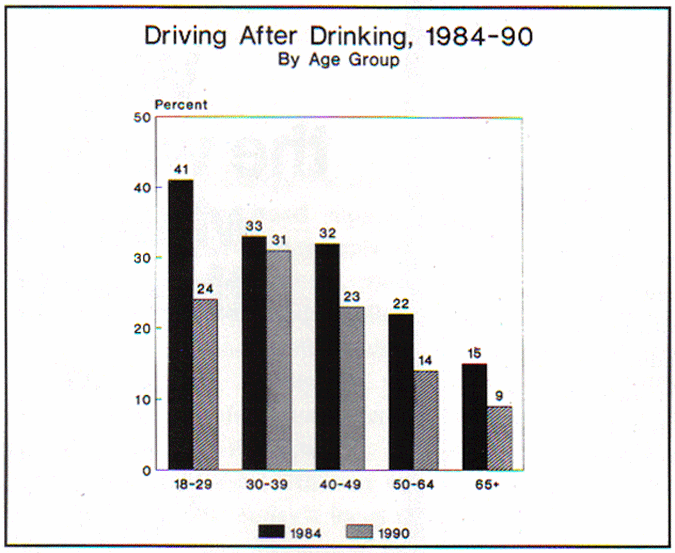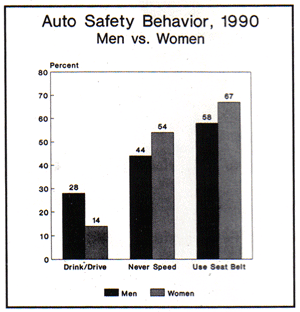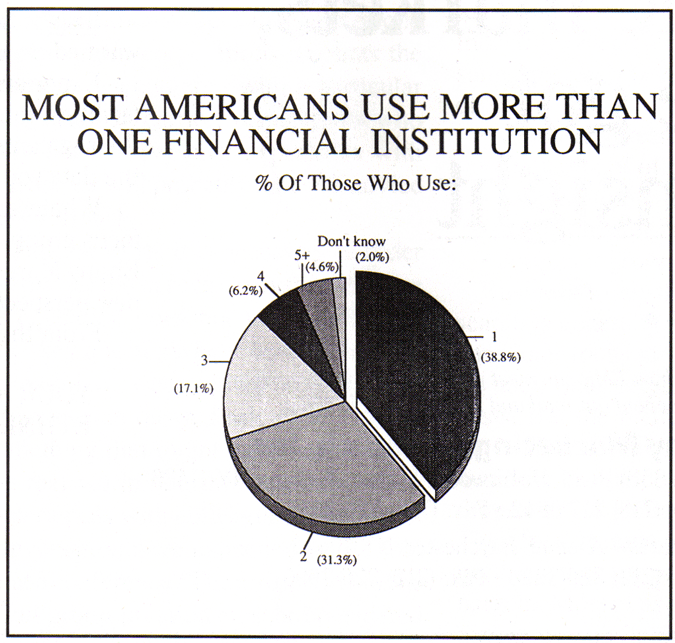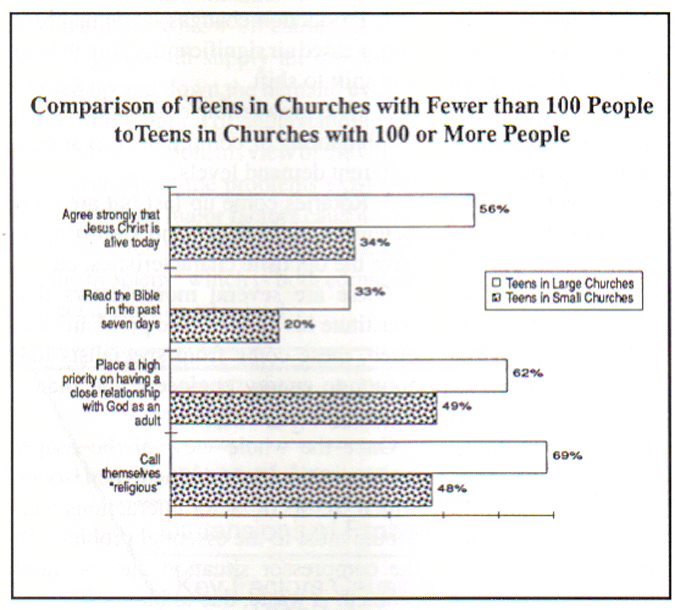Poll finds Americans unsure of air bags, tough on drunk driving
Decades of technical innovations and governmental regulations designed to make the nation's highways safer have resulted in widespread support for stricter auto safety and drunk driving measures, yet many individuals remain confused about the role and value of auto safety devices, according to a nationwide survey conducted for General Motors and Prevention magazine by Louis Harris and Associates, Inc.
The survey found overwhelming support among adults for the imposition of state laws requiring the wearing of seat belts. Overall, eighty-one percent of those questioned support such measures. However, only a slight majority of those questioned - 51 % - believe that air bags offer better protection in a crash than just seat belts.

The survey found that 72% of adults questioned in states without seat belts would support governmental policies mandating seat belt usage. In addition, in states that already have seat belt laws, 83% of adults surveyed say they favor these laws.
Americans are extremely concerned about the safety of airbags. Among those surveyed, 18% or nearly one in five adults believe that air bags can cause serious injury when they inflate. Similarly, 35% believe that air bags can trap people in their cars when inflated. In addition, thirty eight percent of those asked say that accidental inflation of airbags is a serious problem. Although individuals expressed great concern over the value of air bags, a significant minority of those questioned - nearly 30% - say they would be willing to pay an additional $500 for a car equipped with an air bag.
The study found that American men have more confidence in the value of air bags than do women. According to the findings, 59% of the men surveyed say that air bags provide better crash protection than seat belts in an accident compared to only 43% percent of women who expressed this confidence.
"There is no doubt that the high level of uncertainty about the safety of air bags contributes to the limited interest in spending more for these devices," says Thomas Dybdahl, of Prevention, and author of the report. "Greater public understanding of air bags and their benefits would likely result in greater willingness to pay for them."
 The study also attempted to determine the impact of tougher enforcement of laws relating to drunk driving on the behavior of drivers across the nation. One key finding is that one in five Americans admits to driving after drinking. Even more alarming is the fact that college educated, affluent professionals are almost four times as likely to drive after drinking than those without high school diplomas (31% vs. 8%).
The study also attempted to determine the impact of tougher enforcement of laws relating to drunk driving on the behavior of drivers across the nation. One key finding is that one in five Americans admits to driving after drinking. Even more alarming is the fact that college educated, affluent professionals are almost four times as likely to drive after drinking than those without high school diplomas (31% vs. 8%).
Additionally, people with household incomes of above $50,000 drive after drinking at more than double the rate of those with incomes below $15,000 (32% vs. 15%).
The survey found a significant difference in the behavior of men compared to women in the area of driving after drinking. According to the report, men are "twice as likely" as women to drive after drinking. Twenty eight percent of men admit to this behavior compared to 14% of women.
There has been a surprising drop over the past seven years in the percentage of young people who say they dive after drinking. Since 1986, there has been a 17 point decrease (from 41% to 24%) in the numbers of adults aged 18-29 who say they sometimes drive after drinking. In sharp contrast, among those aged 30-39, there has been only a two percentage point decline (from 33% to 31%) in those saying they sometimes drive after drinking.
Americans have little tolerance for drunk driving, the survey found. Among those questioned, nearly two-thirds, or sixty-four percent, would like to see the minimum age drinking law enforced more vigorously. And, seventy-nine percent support expanded use of police roadblocks or check points to reduce drunk driving.
The extent of Americans' concern about enforcing drunk driving laws is most notable among those who support automatic suspension or revocation of a driver's license for driving when drunk, with eighty-nine percent of adults favoring such measures.
This support is spread across the national spectrum, and is even voiced among those who admit to driving after drinking, with four out of five of these individuals supporting license and license plate suspension for drunk driving offenses.
Confidence in banking system wanes
According to a recent national telephone survey conducted by Maritz Marketing Research, over 1/3 of Americans are less confident in the U.S. banking system now than a year ago. A few (7%) are more confident. However, the majority (52%) remains about as confident as last year.
Americans who depend on one financial institution for services are now in the minority. About 40% of people continue to use a single financial institution. But, according to the poll, nearly 60% use multiple institutions. Of those, 31% use two, 17% use three, and 11% use four or more.
Meeting service expectations has become a critical strategy in today's competitive marketplace. Over 90% of Americans say their primary financial institution meets their expectations all or most of the time. Seven percent say their expectations are met only some of the time.
Most people are satisfied overall with their primary financial institution. On a scale of 1-10, with ten being very satisfied, a full 1/3 rate their satisfaction a perfect 10. Eighteen percent rate their satisfaction as a 9, while 26% say it's an 8.

"In general, these are very favorable scores," says Beth Nieman, research manager at Maritz, "but there is significant room for improvement. Ideally, a firm needs as high a score as possible to retain customers and continue to grow. Financial institutions with scores of 7 or below (23%) may be particularly vulnerable to competitors."
Interestingly, almost twice the number of women as men give financial institutions a perfect score on customer satisfaction. Forty-three percent of women rate it a 10, whereas only 23% of men do so.
Economic woes increase coupon use
In a recent survey by NCH Promotional Services, the nation's largest coupon processor, 54% of shoppers interviewed said the recession has caused them to increase their use of coupons for grocery products and health and beauty aids. Seventy-five percent said they intend to increase their use of coupons in the com-ing year.
Smaller churches have difficulty reaching teens
About half of all churches in America have fewer than 100 people in the congregation. A study by the Barna Research Group suggests that these small churches may be having a limited impact on the spiritual lives of the teenagers to whom they minister. The study, Today's Teens: A Generation in Transition, details some of the differences between teenagers who attend a church with fewer than 100 people and those who attend a larger church. The findings reveal differences in the spiritual beliefs and involvement between the two groups of teens.
For instance, whole 69% of the teens from larger churches call themselves "religious," only 48% of the respondents from smaller churches would use this term to describe themselves. In looking toward what they want their adult life to be like, teens from larger churches were more likely to regard having a close rela-tionship with God as a very important priority (62% to 49%). They were also more likely to place a high priority on being part of a local church when they are adults than were teens from smaller churches (49% to 34%).
Teenagers who attended a church with 100 or more people in the congregation also tended to have a more active involvement in the life of the church than did teens from smaller congregations.
Among the teens from larger churches, 33% read the Bible in the week preceding their interview, and 62% went to church. Among teenagers from smaller churches, only 20% read the Bible in the week before their interview, and only 40% had attended church.
Not only were teens in larger churches more involved, they were also more likely to agree strongly with a number of statements about basic Christian beliefs. For example, 79% of the teens in larger congregations agreed strongly that, "Jesus Christ rose from the dead and reappeared on Earth after His resurrection," compared to 55% of the teens from smaller churches.
George Barna, president of the Glendale, California-based Barna Research Group, says that ministry to teens is very different from ministry to adults. "Teens form a unique subculture in our population, with a unique set of needs, problems, and goals. Trying to reach them in the same way adults are reached will not address this unique position."
Barna offers a few possible reasons why smaller churches may lag behind their larger companions in ministry to teens. "Many small churches are under the leadership of a single pastor, who is expected to act as leader, counselor, business director, and teacher. The pastor is also expected to address the needs of various groups within the congregation, including teens.
"In many cases, that pastor has neither the time nor the gifts to reach out to teens in an effective manner. Some small churches also lack a sufficient number of teens to have an effective program, or the church may be relying on lay people who are not truly prepared to minister to today' s teenager. Those churches often end up trying to reach teens the same way they minister to adults, because they aren't able to reach out in any other fashion."
